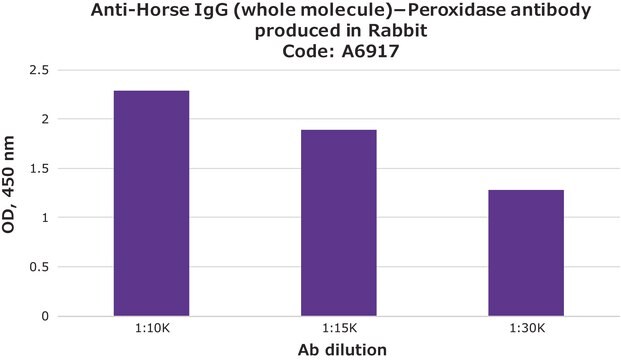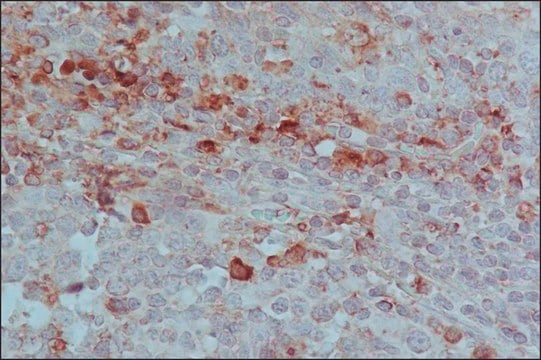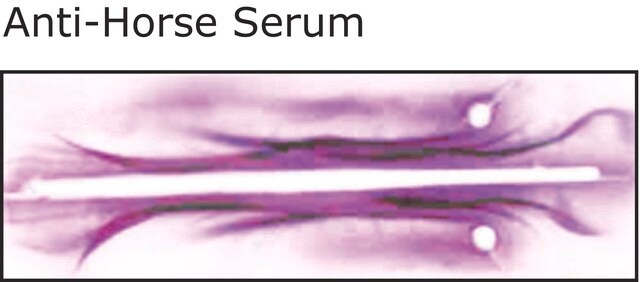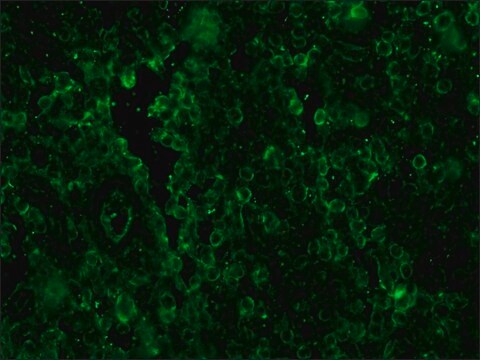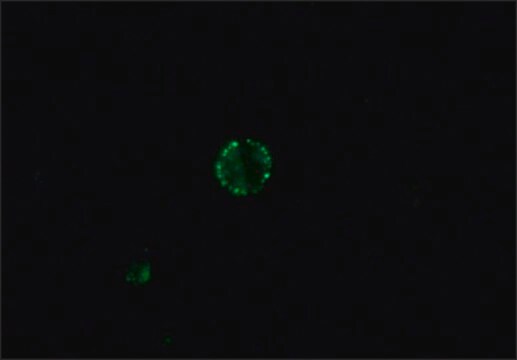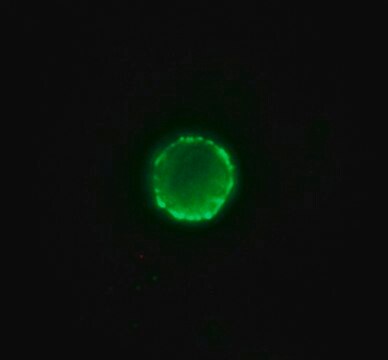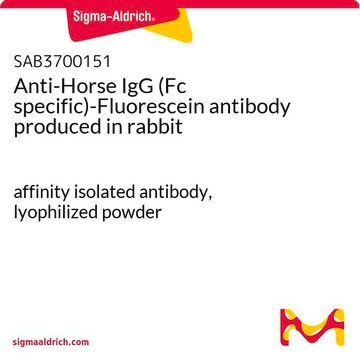F7759
Anti-Horse IgG (whole molecule)−FITC antibody produced in rabbit
affinity isolated antibody, buffered aqueous solution
Synonym(s):
Rabbit Anti-Horse IgG (whole molecule)−Fluorescein isothiocyanate
Sign Into View Organizational & Contract Pricing
All Photos(1)
About This Item
Recommended Products
biological source
rabbit
Quality Level
conjugate
FITC conjugate
antibody form
affinity isolated antibody
antibody product type
secondary antibodies
clone
polyclonal
form
buffered aqueous solution
storage condition
protect from light
technique(s)
direct immunofluorescence: suitable
storage temp.
−20°C
target post-translational modification
unmodified
Looking for similar products? Visit Product Comparison Guide
Related Categories
General description
An immunoglobulin has two heavy chains and two light chains connected by disulfide bond. It is a glycoprotein. IgG is a major class of immunoglobulin. Horse IgG has different subclasses, IgG2a, IgG2b, IgG2c, IgG1 and IgG(T). Compared to other IgG molecules, IgG(T) has more carbohydrate content. In healthy individuals, total IgG is dispersed equally between circulating plasma and interstitial fluids.
Horse IgG is a plasma B cell derived antibody isotype defined by its heavy chain. IgG is the most abundant antibody isotype found in horse serum. IgG crosses the placental barrier, is a complement activator and binds to the Fc-receptors on phagocytic cells. The level of IgG may vary with the status of disease or infection.
Specificity
Anti-horse IgG (whole molecule)-FITC antibody is specific for horse IgG subclasses.
Immunogen
Purified horse IgG
Application
Anti-Horse IgG (whole molecule) FITC antibody produced in rabbit has been used in indirect fluorescent antibody test. It has also been used as a secondary antibody to confirm equine arteritis virus (EAV).
Rabbit polyclonal anti-Horse IgG (whole molecule)−FITC antibody may be used to detect and quantitate the level of IgG in horse serum and biological fluids by fluorescent techniques. It may also be used as a secondary antibody in assays that use horse IgG as the primary antibody.
Biochem/physiol Actions
IgG antibody subtype is the most abundant serum immunoglobulin of the immune system. It is secreted by B- cells and is found in blood and extracellular fluids and provides protection from infections caused by bacteria, fungi and viruses. Maternal IgG is transferred to the fetus through the placenta that is vital for immune defense of the neonate against infections.
Immunoglobulin G (IgG) participates in hypersensitivity type II and type III. It mainly helps in immune defense.
Physical form
Solution in 0.01 M phosphate buffered saline, pH 7.4, containing 1% bovine serum albumin and 15 mM sodium azide
Storage and Stability
For continuous use, store at 2-8 °C for up to one month. For extended storage, the solution may be frozen in working aliquots. Repeated freezing and thawing or storage in "frost-free" freezers, is not recommended. If slight turbidity occurs upon prolonged storage, clarify the solution by centrifugation before use.
Disclaimer
Unless otherwise stated in our catalog or other company documentation accompanying the product(s), our products are intended for research use only and are not to be used for any other purpose, which includes but is not limited to, unauthorized commercial uses, in vitro diagnostic uses, ex vivo or in vivo therapeutic uses or any type of consumption or application to humans or animals.
Not finding the right product?
Try our Product Selector Tool.
Storage Class Code
10 - Combustible liquids
WGK
WGK 3
Flash Point(F)
Not applicable
Flash Point(C)
Not applicable
Personal Protective Equipment
dust mask type N95 (US), Eyeshields, Gloves
Choose from one of the most recent versions:
Already Own This Product?
Find documentation for the products that you have recently purchased in the Document Library.
Manuela Scarpulla et al.
Annals of the New York Academy of Sciences, 990, 259-263 (2003-07-16)
The authors review equine granulocytic ehrlichiosis (EGE) in Italy from 1996 to 2002. In 1996, the first case of EGE has been observed in a horse affected with specific symptomatology (fever, lethargy, anorexia, limb edema, thrombocytopenia, and petechiae). In 1997
A 34-year retrospective study of equine viral abortion in Poland
Bazanow BA, et al.
Polish Journal of Veterinary Sciences, 17(4), 607-612 (2014)
Advances in Immunology (1964)
Factors associated with the distribution of natural Toxoplasma gondii infection among equids in Northeastern Brazil
Munhoz AD, et al.
Revista Brasileira de Parasitologia veterinaria = Brazilian Journal of Veterinary Parasitology : Org?o Oficial do Colegio Brasileiro de Parasitologia Veterinaria, 28(2), 283-290 (2019)
Molecular Genetics of Immunoglobulin (1987)
Our team of scientists has experience in all areas of research including Life Science, Material Science, Chemical Synthesis, Chromatography, Analytical and many others.
Contact Technical Service